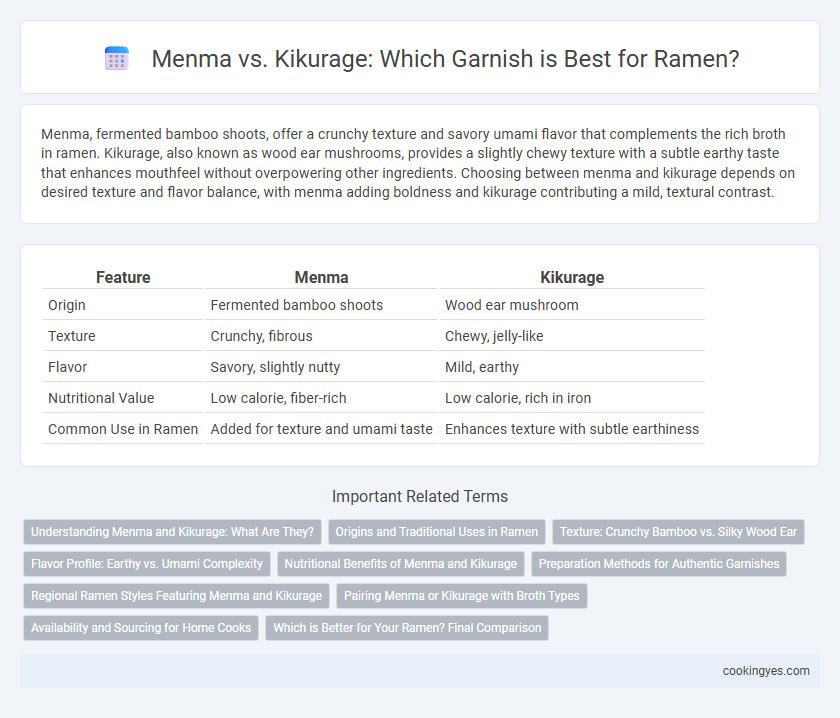Menma, fermented bamboo shoots, offer a crunchy texture and savory umami flavor that complements the rich broth in ramen. Kikurage, also known as wood ear mushrooms, provides a slightly chewy texture with a subtle earthy taste that enhances mouthfeel without overpowering other ingredients. Choosing between menma and kikurage depends on desired texture and flavor balance, with menma adding boldness and kikurage contributing a mild, textural contrast.
Table of Comparison
| Feature | Menma | Kikurage |
|---|---|---|
| Origin | Fermented bamboo shoots | Wood ear mushroom |
| Texture | Crunchy, fibrous | Chewy, jelly-like |
| Flavor | Savory, slightly nutty | Mild, earthy |
| Nutritional Value | Low calorie, fiber-rich | Low calorie, rich in iron |
| Common Use in Ramen | Added for texture and umami taste | Enhances texture with subtle earthiness |
Understanding Menma and Kikurage: What Are They?
Menma and Kikurage are popular ramen garnishes that enhance texture and flavor; Menma is fermented bamboo shoots offering a crunchy, slightly tangy taste, while Kikurage, also known as wood ear mushrooms, provides a chewy, earthy texture. Both ingredients are rich in umami and complement the savory broth and noodles uniquely. Understanding their distinct characteristics helps ramen enthusiasts choose the perfect garnish to elevate their bowl.
Origins and Traditional Uses in Ramen
Menma, fermented bamboo shoots originating from Chinese cuisine, are prized in ramen for their crunchy texture and savory umami flavor, traditionally added to enhance broth complexity. Kikurage, or wood ear mushrooms native to East Asia, provide a unique chewy texture and subtle earthiness, commonly used in tonkotsu ramen to balance rich, fatty broths. Both garnishes contribute distinct regional authenticity, reflecting Japanese adaptations of Chinese culinary elements in ramen heritage.
Texture: Crunchy Bamboo vs. Silky Wood Ear
Menma offers a distinct crunchy texture created by fermented bamboo shoots, providing a robust bite that contrasts well with the soft noodles in ramen. Kikurage, or wood ear mushrooms, deliver a silky and slightly chewy mouthfeel that adds a subtle earthiness without overpowering the broth. Choosing between Menma and Kikurage hinges on the desired texture experience: crunchy and firm versus silky and chewy, each enhancing ramen in unique tactile ways.
Flavor Profile: Earthy vs. Umami Complexity
Menma offers a distinct earthy flavor with a slightly sweet and fermented taste, enhancing ramen with a crunchy texture that contrasts well with rich broths. Kikurage, known as wood ear mushrooms, provides a subtle umami complexity and a delicate, jelly-like texture that absorbs broth flavors for a savory depth. Choosing between Menma and Kikurage depends on whether you prefer an earthy crunch or a mild umami richness as a ramen garnish.
Nutritional Benefits of Menma and Kikurage
Menma, fermented bamboo shoots, provide dietary fiber, essential minerals like potassium and manganese, and low calories, boosting digestion and mineral balance in ramen. Kikurage, or wood ear mushrooms, are rich in antioxidants, iron, and vitamin D, supporting immune health and blood circulation. Both garnishes enhance ramen's nutritional profile by contributing unique vitamins and minerals that promote overall wellness.
Preparation Methods for Authentic Garnishes
Menma, made from fermented bamboo shoots, undergoes a lengthy marinating process in soy sauce, sugar, and mirin to achieve its savory, slightly sweet flavor essential for authentic ramen. Kikurage, or wood ear mushrooms, is typically soaked and briefly blanched to retain a crisp texture, providing a contrasting crunch without overpowering the broth's delicate umami. Both garnishes enhance ramen's complexity through distinct preparation methods, emphasizing balance and tradition in Japanese cuisine.
Regional Ramen Styles Featuring Menma and Kikurage
Menma, fermented bamboo shoots, commonly appear in Tokyo-style and Sapporo ramen, adding a savory crunch that complements rich broths. Kikurage, or wood ear mushrooms, are predominantly found in Hakata and Kyushu-style tonkotsu ramen, providing a chewy texture and mild earthiness. These garnishes reflect regional preferences, enhancing the distinctive flavor profiles and textures of Japan's diverse ramen varieties.
Pairing Menma or Kikurage with Broth Types
Menma, the seasoned bamboo shoots, pair exceptionally well with rich, pork-based tonkotsu broth, adding a crunchy texture and savory depth that complements the creamy soup. Kikurage, or wood ear mushrooms, are ideal for lighter, soy-based shoyu broths, offering a subtle earthiness and a crisp bite that enhances the broth's umami without overpowering it. Choosing between menma and kikurage depends on the ramen's broth intensity and flavor profile, optimizing the balance of texture and taste in each bowl.
Availability and Sourcing for Home Cooks
Menma, fermented bamboo shoots, are often found in Asian grocery stores and online retailers, making them relatively accessible for home cooks seeking authentic ramen garnishes. Kikurage, or wood ear mushrooms, can be sourced fresh in specialty stores or dried from various Asian markets, offering versatility but requiring rehydration before use. Both garnishes provide unique textures and flavors, but menma's ready-to-eat convenience often appeals more to home cooks prioritizing ease of preparation.
Which is Better for Your Ramen? Final Comparison
Menma and Kikurage offer distinct textures and flavors that complement ramen differently: Menma provides a crunchy, slightly fermented bamboo shoot flavor, enhancing umami depth, while Kikurage delivers a chewy, earthy mushroom texture, adding subtle complexity. Nutritionally, Kikurage contains beneficial dietary fiber and antioxidants, contributing to a healthier bowl, whereas Menma's fermentation process supports digestion. Choosing between them depends on whether you prefer a tangy crunch or a mild, chewy texture to elevate your ramen experience.
Menma vs Kikurage for ramen garnishes Infographic

 cookingyes.com
cookingyes.com